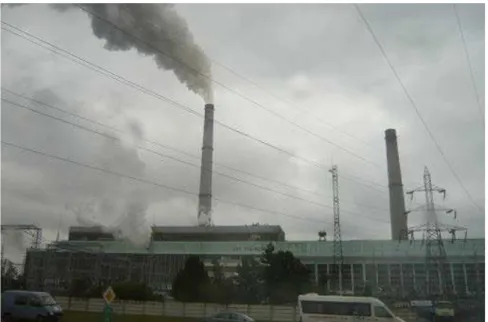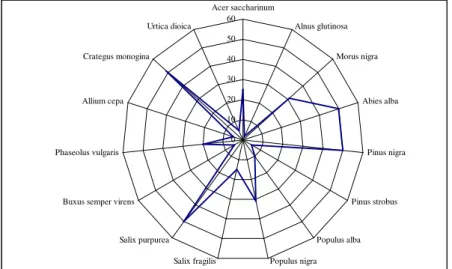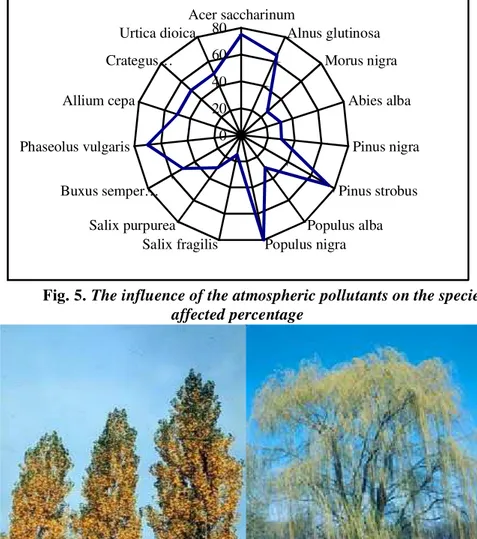THE IMPACT OF SOME AIR POLLUTANTS ON THE
VEGETATION NEARBY THE INDUSTRIAL PLATFORMS
POPESCU SIMONA MARIANA1, GAVRILESCU ELENA1
ABSTRACT. The impact of some air pollutants on the vegetation nearby the industrial platforms. Plants are affected primarily by air pollution. This is
generated by the accumulation in the atmospheric air of gaseous chemical
compounds or solid particles in the form of powder, which are then deposited on the ground. The gaseouse pollutants result from industrial activities, such as the
sulphur compounds (SO2, SO3, H2S, carbon sulphide), nitrogen oxides (NO, NO2)
and carbon (CO and CO2). The impact of air pollution can cause severe damages
to the plants located near industrial areas, especially because the most Romanian thermal power plants were built in a period when their operation impact on the environment was undervalued, and the constraints related to the environmental protection were relatively few. The pollutants enter plants through stomata causing a reduction of metabolic processes. The study has been conducted during 2010-2012 in Craiova City, in the area of the powerplant CET I – Isalnita, on 15 species both annual and perenae from spontaneous plants in the influence area. The observations were particularly conducted for the following purposes: identification of the inflicted organs (leafs, bodies, branches); percentage of the organs inflicted; the pollutant implied; to answer what kind of pollutant is implied; to classify the
species with regard to their sensibility to the studied pollutants, respectevily: NO2,
SO2, PM10. The main result of this study are: the main pollutants, which affects the
vegetation are SO2, NO2 and particulate matter, this pollutants affecting more the
leafs than the bodies of the plants, the number of individuals affected varies between 15-70 %; the following species can be considered as bioindicator: Pinus nigra, Urtica dioica, Phaseolus vulgaris.
Key words: air pollution impact, industrial platforms, vegetation, morphological analyses
1. INTRODUCTION
Urban and industrial human activity have a pollutant effect on the environment, directly proportional to the specific activity, visible in areas more or less extended and dependent to a great extent on climatic conditions. The distribution and atmospheric processes of pollution and its effects on environment are influenced by climate, topography, demography, and socioeconomic profile of the region (Ilten and Selici, 2008).
1
University of Craiova, Faculty of Agriculture and Horticulture, Craiova, Romania, e-mail:
popescu_simona83@yahoo.com, gavrilescu_elena@yahoo.com
The main sources of pollution are industry, agriculture, transport and human communities. They cause air, water, soil and biosphere pollution. Plants are affected primarily by air pollution. This is determined by the accumulation in the atmospheric air of gaseous chemical compounds or solid particles in the form of powder, which are then deposited on the ground.
The gaseous pollutants result from industrial activities, such as the sulphur compounds (SO2, SO3, H2S, carbon sulphide), nitrogen oxides (NO, NO2) and
carbon (CO and CO2). Sulphur and nitrogen oxides are combining with water in
the atmosphere forming H2SO4 and HNO3 acids, which fall on the plant as acid
rain. Other pollutants are compounds and substances as NH3, HCl, Cl, F etc.
Hydrocarbons, aldehydes and cetones from various industrial activities are transformed in the presence of sunlight in gaseous pollutants such as acids, ozone or benzopyrene.
Accumulated solid particles in the atmosphere are represented by charcoal, ashes, dust of heavy metals (Cd, Cu, Zn, Hg, Pb) and light powder (lime, gypsum, cement). They are originated in different kinds of industry or in transportation. They fall on plants or on soil where cause a high degree of pollution.
The pollutants enter plants through stomata causing a reduction of metabolic processes. The atmospheric pollutants cause perturbation of physiological processes, which consist in the production of cellular and tissue damage, metabolic and growth disorders, full drying of plants. Absorption is limited by stomata conductivity and cuticle conductivity: the absorption intensity is directly related to the stomata opening degree and cuticle permeability. In cells and tissues, pollutants cause chloroplasts, ribosomes and other organelle toxicity, and corresponding reduction of metabolic processes.
As external impact, the action of pollutants produce visible symptoms, especially on the leaves. Considering the colour of leaves we can identify the pollutant. First, the leaves are etiolated, then are necrosated, and finally they are completed dried and fall.
2. THE ANALYSIS OF AIR QUALITY AND THE EFFECTS OF AIR POLLUTION ON THE PLANTS IN THE AREA OF INDUSTRIAL PLATFORMS
The impact of air pollution can cause severe damages to the plants located near industrial areas, especially because the most Romanian thermal power plants were built at a time when their operation impact on the environment was undervalued, and the constraints related to the environmental protection were relatively few (Popescu et al, 2012).
The presence of Isalnita industrial platform (Fig. 1) near a dens populated area (Craiova City) has a major impact on all the economic fields in the area. Among the pollution effects the air pollution is one of the main parts of the environment that is most important.
Fig. 1. CET I Isalnita, Craiova
Through the activities profile, the input and the output products, the technologies that are used, the Industrial platform must be taken as important possible pollution issue in the area.
The climate of Craiova city is temperate continental, with mean annual temperature of 10.7° C. For July and August the mean temperature reaches 22,2 0C, and 21.7 0C respectively . The annual rainfall amount is of 569.9 mm; the most rainy months are June and May, with monthly mean of 70.2 mm and 63.4 mm respectively (Sandu et al., 2008).
organs (leafs, bodies, branches); percentage of the organs inflicted; the pollutant implied; finding the answer of what kind of pollutant is implied; to classify the species with regard to their sensibility to studied pollutants, respectively: NO2,
SO2, PM10.
Air quality monitoring was performed using a portable multigas detector Oldham (Model MX 21 – Plus Multigas, France) and the assessment of the effects of air pollutants on the studied plants was achieved by tracking some morfological indicators.
The pollutants input in the atmosphere (mean values) are presented in Fig. 2.
0.000 0.050 0.100 0.150 0.200 0.250 0.300 0.350 0.400 0.450
500 10001500200025003000
km
0.000 0.010 0.020 0.030 0.040 0.050 0.060
NOx
SO2
Fig. 2. The concentration of pollutants (NOx and SO2) discharged from Isalnita Industrial Platform (mg/m3)
Under these conditions the percentage of affected leafs of the studied species is between 15-75 %, the area of pollution has an extension of 0,3-0,7 km in diameter. It is obvious a higher degree of affected leafs, the species Pinus strobus – 75 % (3rd type of pollution – heavy); Phaseolus vulgaris – 50 % (2-nd type of pollution – dangerous); Salix purpurea – 15 % (first type of pollution – obvious) (Fig. 3).
Considering the degree of affected bodies we observed for the species
Abies alba and Pinus nigra (2-nd type of pollution – dangerous) that 50 % of the plant population were injured at. The less affected were the bodies of the species
Alnus glutinosa (2%), Buxus sempervirens (5%) and Pinus strobus (5%) (first type of pollution – obvious) (Fig. 4).
This species were affected especially about the pollutants, which contains a higher concentration of SO2. The reaction of this pollutant with the atmospheric
From the total of the individuals, which were considered for this study, 75% belong to the Pinus strobus species, 70% to Phaseolus vulgaris, whereas a minimum number of individuals affected belong to the specie of Salix fragilis
(15%) (Fig.5).
0 20 40 60 80
Acer saccharinum
Alnus glutinosa
Morus nigra
Abies alba
Pinus nigra
Pinus strobus
Populus alba
Populus nigra Salix fragilis
Salix purpurea Buxus semper virens Phaseolus vulgaris
Allium cepa Crategus monogina
Urtica dioica
Fig. 3. The influence of the pollutants on the leafs percentage on the studied species
0 10 20 30 40 50 60 Acer saccharinum
Alnus glutinosa
Morus nigra
Abies alba
Pinus nigra
Pinus strobus
Populus alba
Populus nigra Salix fragilis
Salix purpurea Buxus semper virens Phaseolus vulgaris
Allium cepa Crategus monogina
Urtica dioica
3. CONCLUSIONS
The study highlights that the pollutants emissions of the thermal power plant affect the environment and the plants located in the vicinity of the industrial platform.
0 20 40 60 80
Acer saccharinum
Alnus glutinosa
Morus nigra
Abies alba
Pinus nigra
Pinus strobus
Populus alba Populus nigra Salix fragilis
Salix purpurea Buxus semper… Phaseolus vulgaris
Allium cepa Crategus…
Urtica dioica
Fig. 5. The influence of the atmospheric pollutants on the species affected percentage
From this study it results:
the main pollutants of Isalnita industrial platform, affecting the vegetation are SO2, NOx and the sediments;
this pollutants affect more the leafs than the bodies of plants and the number of individual affected varies between 15 and 70%;
the majority of species belong to the second type of pollution (dangerous);
the following species can be considered as bioindicators: Pinus nigra, Urtica dioica, Phaseolus vulgaris.
In the case of areas exposed to atmospheric pollution, it is absolutely necessary to take measures of air depollution, so that the pollutants entering into the atmosphere by various industrial sources, as it is the case for the studied area, do not affect the integrity and productivity of plants.
For a better understanding on how the air pollutants affect the plants further physiological analysis are necessary and also the concentration of the air pollutants emitted into the atmosphere must be correlated with the climatic condition for the specific area.
REFERENCES
1. ALSCHER, R. G.(1994), Plant Responses to Gaseous Environment, Chapman and Hall, London, UK.
2. FRANZLE O. (1993), Contaminants in Terrestrial Environments, Springer, New York.
3. JITAREANU, Carmen Doina (2007), Fiziologia plantelor, Editura Ion Ionescu de la Brad, Iasi.
4. TEUSDEA V. (2000), Protectia mediului, Editura Fundatiei “Romania de Maine”.
5. POPESCU Simona Mariana, Popa A., Gavrilescu Elena & Gruia M. (2012),
The effects of air pollution on the main physiological processes of the grapevine grown in the vicinity of a power plant, Carpathian Journal of Earth and Environmental Sciences, Vol. 7, No. 4, p. 61 – 70.
6. ILTEN N. and Selici A.T. (2008), Investigating the impacts of some meteorological parameters on air pollution in Balikesir, Turkey. Environ Monit Assess. 140, 267–277.
7. SANDU I., Ţâştea D., Geicu A., Baltă D., Oprea C., Soare E., Ghiţescu N.,
Săraru L., Dumitrescu A., Hârsescu S., Alexandrescu R., Călinescu Ghe., Cândea I., Dragotă C., Baciu, M., Breza, T., Becheanu, V., Mărcuşi, I.
(2008), Romania's climate (Clima României), Editura Academiei Române,
Bucureşti, 48-70.
8. POPESCU Simona Mariana, Gavrilescu Elena (2012), The monitoring of air pollution from an urban area in Craiova City,Analele Universităţii din



